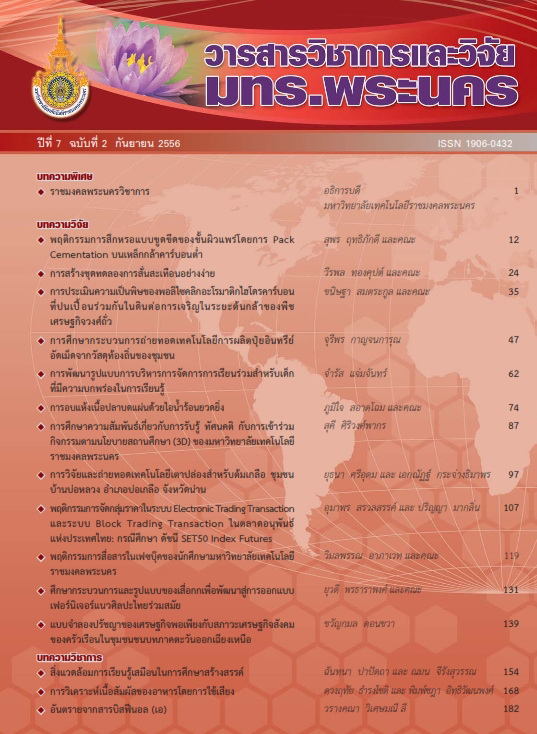พฤติกรรมการจัดกลุ่มราคาในระบบ ELECTRONIC TRADING TRANSACTION และระบบ BLOCK TRADING TRANSACTION ในตลาดอนุพันธ์แห่งประเทศไทย : กรณีศึกษา ดัชนี SET50 INDEX FUTURES
Main Article Content
Abstract
บทคัดย่อ
งานวิจัยนี้ศึกษาพฤติกรรมการจัดกลุ่มราคาในระบบ Electronic Trading Transaction และระบบ Block Trading Transaction ภายในตลาดอนุพันธ์แห่งประเทศไทย จากดัชนี SET50 Index Futures โดยใช้ข้อมูลราคา ปิดรายวันของดัชนี SET50 Index Futures ตั้งแต่วันที่ 28 เมษายน พ.ศ. 2549 จนถึงวันที่ 30 มิถุนายน พ.ศ. 2555 ทำการวิเคราะห์สถิติเชิงพรรณนาและการวิเคราะห์เชิงปริมาณ ประกอบด้วย ไค-สแควร์ (Chi-square) เพื่อทดสอบการแจกแจงแบบ Uniform ดัชนี Hirshmann-Herfindal Index (HHI) วัดความหนาแน่นของราคา ค่าพิสัยมาตรฐาน(Standardized Range) และค่าส่วนเกินของการจัดกลุ่มราคา (Excess Clustering) วัดการจัดกลุ่มราคา และ Multiple Regression ตรวจสอบพฤติกรรมการจัดกลุ่มราคา ผลการวิจัยพบว่าพฤติกรรมการจัดกลุ่มราคาในดัชนี SET50 Index Futures มีลักษณะเป็นรูปแบบเดียวกัน กล่าวคือมีเลขสองตัวสุดท้ายที่เกิดขึ้นบ่อยคือ 00 (32.31%) และ 50 (13.82%) สำหรับเลขสองตัวสุดท้ายตัวอื่นมีความถี่ไม่เกิน 8% มีการจัดกลุ่มราคาเพิ่มขึ้นพร้อม ๆ กับปริมาณการซื้อขาย นอกจากนี้ยังพบว่าราคาในช่วงเปิดตลาด ช่วงห่างระหว่างราคาเสนอซื้อและเสนอขายและค่าความผันผวน มีผลกระทบในเชิงบวกต่อการจัดกลุ่มราคา แต่ราคาในช่วงปิดตลาดมีผลกระทบในเชิงลบกับการจัดกลุ่มราคา สำหรับอัตราผลตอบแทนรวม พบว่าไม่ส่งผลกระทบใดๆ ต่อการจัดกลุ่มราคา ที่ระดับนัยสำคัญ 0.05
Abstract
This research studied behavior of price clustering in Electronic Trading Transaction and Block Trading Transaction in Thailand Futures Exchange market from SET50 Index Futures using daily closing price data of SET50 Index Futures from April 28, 2006 to June 30, 2012. Descriptive statistics and quantitative analysis included Chi-square to test Uniform Distribution; Hirshmann-Herfindal Index (HHI) to measure price density, Standardized Range and Excess Clustering to measure price clustering; and Multiple Regression to test behavior of Price Clustering. Results showed that the behavior of price clustering in SET50 Index Futures was characterized in the same way. That is, the most frequent last two digits were 00 (32.31%) and 50 (13.82%) while other last two digits had the frequency of not greater than 8%. There was more price clustering along with the trading volume. It also found that the opening price, the bid-ask spread, and the volatility had positive impacts on price clustering while the closing price had negative impact. For the total return, no impact was found on price clustering at the significant level of 0.05.


